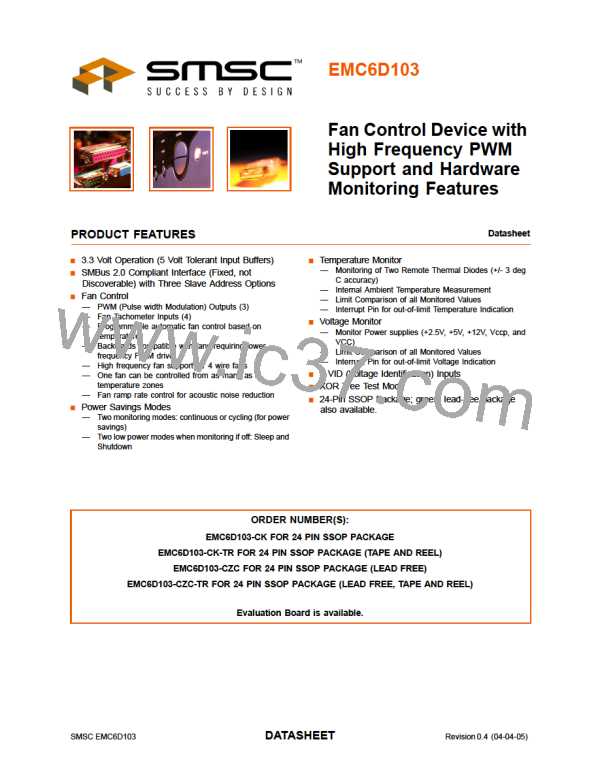Fan Control Device with High Frequency PWM Support and Hardware Monitoring Features
Datasheet
Chapter 1 General Description
The EMC6D103 is an environmental monitoring device with automatic fan control capability. This ACPI
compliant device provides hardware monitoring for up to five voltages and three thermal zones,
measures the speed of up to four fans, and controls the speed of multiple DC fans using Pulse Width
Modulator (PWM) outputs. High frequency and low frequency PWMs are supported.
The EMC6D103 hardware monitor provides analog inputs for monitoring external voltages of +2.5V,
+5V, +12V and Vccp. This device has the capability to monitor its own internal VCC power supply,
which may be connected to either main power (VCC) or the suspend power well (VTR). In addition to
monitoring the processor voltage, VID inputs are available to identify the voltage specification. External
components are not required for voltage scaling or similar treatment.
The EMC6D103 hardware monitor includes support for monitoring three thermal zones: two external
and one internal. The external temperatures are measured via thermal diode inputs capable of
monitoring remote devices. In addition, they are equipped with an ambient temperature sensor for
measuring the internal temperature.
Pulse Width Modulators (PWM) control the speed of the fans by varying the output duty cycle of the
PWM. Each PWM can be associated with any or all of the thermal zones monitored. As the
temperature of the associated zone varies, the PWM duty cycle is adjusted accordingly. The Ramp
Rate Control feature controls the rate of change of the PWM output, thereby reducing system noise
created by changing the fan speed. The speed of each fan is monitored by a Fan Tachometer input.
The measured values are compared to values stored in Limit Registers to detect if a fan has stalled
or seized.
Fan speed may be under host software control or automatic. In host control mode, the host software
continuously monitors temperature and fan speed registers, makes decisions as to desired fan speed
and sets the PWM’s to drive the required fan speed. This device offers an interrupt output signal
(INT#), which may be used to interrupt the host on out-of-limit temperature or voltage condition
enabling an ACPI response as opposed to the host software continuously monitoring status. In auto
“zone” mode, the logic continuously monitors the temperature and fan speeds and adjusts speeds
without intervention from the host CPU. Fan speed is adjusted according to an algorithm using the
temperature measured in the selected zone, the high and low limits set by the user, and the current
fan speed.
The EMC6D103 supports two Monitoring modes: Continuous Mode and Cycle Mode. In the continuous
monitoring mode, the sampling and conversion process is performed continuously for each voltage and
temperature reading after monitoring is enabled. The time for each voltage and temperature reading
varies depending on the measurement option. In cycle monitoring mode, the part completes all
sampling and conversions, then waits approximately one second to repeat the process. It repeats the
sampling and conversion process typically every 1.2 seconds (1.4 sec max - default averaging
enabled). The sampling and conversion of each voltage and temperature reading is performed once
every monitoring cycle. (This is a power saving mode.)
The EMC6D103 can be placed in one of two low-power modes: Sleep mode or Shutdown mode. These
modes do not reset any of the registers of the device. In Sleep mode bias currents are on and the
internal oscillator is on, but the the A/D converter and monitoring cycle are turned off. Serial bus
communication is still possible with any register in the Hardware Monitor Block while in this low-power
mode. In Shutdown mode the bias currents are off, the internal oscillator is off, and the the A/D
converter and monitoring cycle are turned off. Serial communication is only possible with a select
register.
Revision 0.4 (04-04-05)
SMSC EMC6D103
DATA1S0HEET

 SMSC [ SMSC CORPORATION ]
SMSC [ SMSC CORPORATION ]